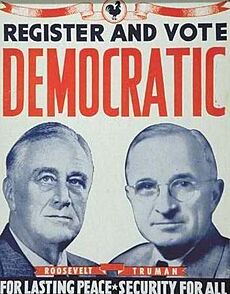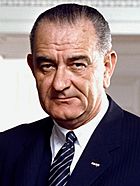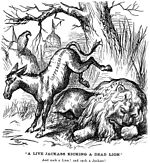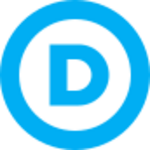Democratic Party (United States) facts for kids
Quick facts for kids
Democratic Party
|
|
|---|---|
| Chairperson | Ken Martin |
| Governing body | Democratic National Committee |
| Senate Minority Leader | Chuck Schumer |
| House Minority Leader | Hakeem Jeffries |
| Founders | |
| Founded | January 8, 1828 Baltimore, Maryland, U.S. |
| Preceded by | Democratic-Republican Party |
| Headquarters | 430 South Capitol St. SE, Washington, D.C., U.S. |
| Student wing |
|
| Youth wing | Young Democrats of America |
| Women's wing | National Federation of Democratic Women |
| Overseas wing | Democrats Abroad |
| Ideology |
|
| Political position | Center-left |
| Caucuses | Blue Dog Coalition New Democrat Coalition Congressional Progressive Caucus |
| Colors | Blue |
| Senate |
45 / 100
|
| House of Representatives |
212 / 435
|
| State governors |
23 / 50
|
| State upper chambers |
832 / 1,973
|
| State lower chambers |
2,385 / 5,413
|
| Territorial governors |
2 / 5
|
| Seats in Territorial upper chambers |
21 / 97
|
| Seats in Territorial lower chambers |
9 / 91
|
| Election symbol | |
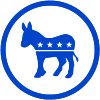 |
|
The Democratic Party is one of the two major political parties in the United States. It is considered a center-left party. Founded in 1828, it is the world's oldest active political party. Its main rival since the 1850s has been the Republican Party. Together, these two parties have shaped American politics for over 150 years.
The party was formed to help elect Andrew Jackson as president. In its early years, it supported farmers and the idea of expanding the country's borders. It was against having a national bank and high taxes on goods from other countries.
Over time, the party's ideas have changed. In the 1930s, President Franklin D. Roosevelt created the New Deal, a series of programs to help people during the Great Depression. This brought together many different groups of voters, including workers, city dwellers, and African Americans.
In the 1960s, the party supported the civil rights movement, which fought for equal rights for all Americans. This led many white voters in the South to switch to the Republican Party. Today, the Democratic Party is most popular with people who live in cities, have a college education, and are younger.
Democrats generally support social programs like universal health care, protecting the environment, and equal rights for all people, including LGBTQ people.
Contents
History
The Democratic Party traces its roots back to the Democratic-Republican Party, which was started by Thomas Jefferson and James Madison in 1792. However, the modern Democratic Party was officially organized in the late 1820s to support the war hero Andrew Jackson for president. His main organizer was Martin Van Buren, who brought together politicians from every state.
Since the late 1800s, the Democratic Party has generally been more to the left on money issues than the Republican Party. Since the 1940s, Democrats have also been more liberal on civil rights.
How the Party Began
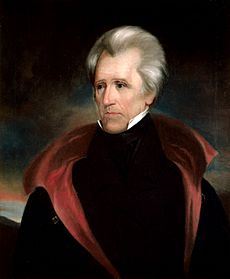
The Democratic Party grew out of the old Democratic-Republican Party. This party believed in a weak central government and more power for the states. After the War of 1812, it was the only major party left, but it soon split into different groups.
Andrew Jackson and Martin Van Buren created the new Democratic Party to unite these groups. They believed the government should represent ordinary people, like farmers and workers. They were against policies that they felt helped rich people and big businesses. Their main rivals were the Whigs.
The 1800s: Civil War and a Changing Nation
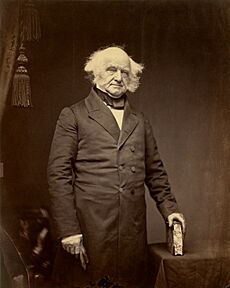
In the years before the American Civil War, the Democratic Party was divided over the issue of slavery. This split helped the new Republican Party and its candidate, Abraham Lincoln, win the presidency in 1860.
After the Civil War, the Democratic Party became strong in the South. Many white Southerners were angry about the changes made during the Reconstruction period. For many years, the South voted almost entirely for Democrats, becoming known as the "Solid South".
During this time, the party was led by pro-business Democrats like Grover Cleveland. He was elected president twice, in 1884 and 1892.
The 1900s: New Ideas and the New Deal
In 1896, the party nominated William Jennings Bryan, who supported farmers and working people. This marked a shift toward more liberal economic ideas. In 1912, Woodrow Wilson was elected president. He passed many progressive laws that changed how the government dealt with business and money.
The Great Depression of the 1930s was a turning point. Franklin D. Roosevelt was elected president in 1932 and launched the New Deal. These programs used the federal government's power to create jobs, help the poor, and regulate banks. The New Deal created a powerful coalition of voters that kept the Democrats in power for decades.
Civil Rights and a Party in Transition
After World War II, the civil rights movement became a major issue. Democratic presidents John F. Kennedy and Lyndon B. Johnson supported laws like the Civil Rights Act of 1964 and the Voting Rights Act of 1965. These laws ended segregation and protected the right of African Americans to vote.
This support for civil rights caused many white Southern Democrats to leave the party and join the Republicans. At the same time, the Vietnam War divided the country and the Democratic Party. These events weakened the party's old coalition.
In 1976, Jimmy Carter, a Democrat from Georgia, was elected president. But his presidency faced challenges, and he lost to Republican Ronald Reagan in 1980.
The 1990s: A Shift to the Center
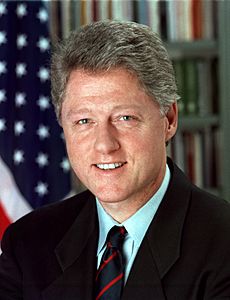
After several losses, the Democratic Party began to move toward the political center. In 1992, Bill Clinton was elected president. He was known as a "New Democrat" who supported a mix of liberal social policies and more moderate economic policies.
Clinton was re-elected in 1996, becoming the first Democrat since Franklin D. Roosevelt to win a second full term. His vice president, Al Gore, ran for president in 2000. Gore won the popular vote but lost the election to George W. Bush in the Electoral College.
The 21st Century
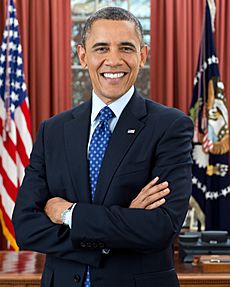
In the 2000s, Democrats focused on issues like health care, the environment, and national security after the September 11, 2001, terrorist attacks. In 2008, Barack Obama was elected as the first African American president. His biggest achievement was the Affordable Care Act, a law that expanded health insurance to millions of Americans.
After Obama, the political climate became even more divided. In 2016, Democrat Hillary Clinton lost the presidential election to Donald Trump, even though she won the popular vote.
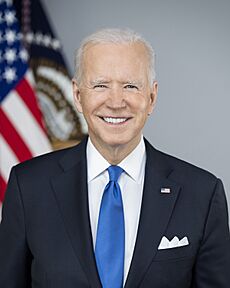
In 2020, Democrat Joe Biden defeated Trump. During his presidency, Biden signed laws to invest in infrastructure, fight climate change, and address economic issues. He also appointed Ketanji Brown Jackson as the first Black woman to serve on the Supreme Court.
In 2024, Vice President Kamala Harris became the first Black woman to be nominated for president by a major party. She lost the election to Donald Trump.
Name and Symbols
The party was first called "The Democracy," but the name "Democratic Party" became official in 1844. Party members are called "Democrats."
The most famous symbol for the party is the donkey. It started as an insult against Andrew Jackson, whose opponents called him a "jackass." Jackson embraced the symbol, and it stuck. Political cartoonist Thomas Nast helped make the donkey famous in the 1870s.
Another old symbol for the party was the rooster, which was used in states like Indiana and Kentucky.
Since the 2000 presidential election, the color blue has been used to represent the Democratic Party on election maps, while red is used for the Republican Party.
What Democrats Believe
The Democratic Party is a big tent party, meaning it includes people with a wide range of views. However, most Democrats share some core beliefs. They generally believe the government should play a role in solving problems and helping people.
Economic Issues
Democrats support policies that they believe create a fairer economy. These include:
- A progressive tax system, where wealthier people pay a higher percentage of their income in taxes.
- A higher minimum wage for workers.
- Strong labor unions to protect workers' rights.
- Social programs like Social Security for the elderly and Medicare for health care.
- Investing in infrastructure (like roads and bridges) and clean energy to create jobs.
Social Issues
On social issues, Democrats tend to be liberal. They support:
- Equal opportunity for everyone, no matter their race, gender, religion, or sexual orientation.
- LGBTQ rights, including the right to marry.
- Gun control measures, such as background checks, to reduce violence.
- Protecting the environment and fighting climate change.
Who Votes for Democrats?
The Democratic Party is supported by a diverse coalition of voters. In recent elections, the party has been most successful with:
- Urban voters: People living in big cities.
- Younger voters: Americans under the age of 40.
- Women: Especially unmarried women.
- Racial and ethnic minorities: The party receives very strong support from African Americans and is also popular with Hispanic and Asian American voters.
- College graduates: People with a bachelor's degree or higher, especially those with graduate degrees.
- LGBTQ people: A large majority of LGBTQ voters support the Democratic Party.
Geographically, the party is strongest on the West Coast, in the Northeast, and in parts of the Midwest.
Democratic Presidents
As of 2025, 16 Democrats have served as President of the United States.
| Name | Years in Office |
|---|---|
| Andrew Jackson | 1829–1837 |
| Martin Van Buren | 1837–1841 |
| James K. Polk | 1845–1849 |
| Franklin Pierce | 1853–1857 |
| James Buchanan | 1857–1861 |
| Andrew Johnson | 1865–1869 |
| Grover Cleveland | 1885–1889 & 1893–1897 |
| Woodrow Wilson | 1913–1921 |
| Franklin D. Roosevelt | 1933–1945 |
| Harry S. Truman | 1945–1953 |
| John F. Kennedy | 1961–1963 |
| Lyndon B. Johnson | 1963–1969 |
| Jimmy Carter | 1977–1981 |
| Bill Clinton | 1993–2001 |
| Barack Obama | 2009–2017 |
| Joe Biden | 2021–2025 |
Images for kids
-
James K. Polk was the 11th president (1845–1849). He greatly expanded the territory of the United States.
-
Stephen A. Douglas was a U.S. senator from Illinois and a leading Democrat before the Civil War.
-
Jimmy Carter, the 39th president (1977–1981).
-
Shirley Chisholm was the first major-party African American candidate to run for president.
-
President Obama signing the Patient Protection and Affordable Care Act into law in 2010.
-
Israeli Prime Minister Benjamin Netanyahu meeting with President Obama in 2013.
-
Bernie Sanders and Alexandria Ocasio-Cortez are leaders of the progressive wing of the Democratic Party.
See also
 In Spanish: Partido Demócrata (Estados Unidos) para niños
In Spanish: Partido Demócrata (Estados Unidos) para niños



